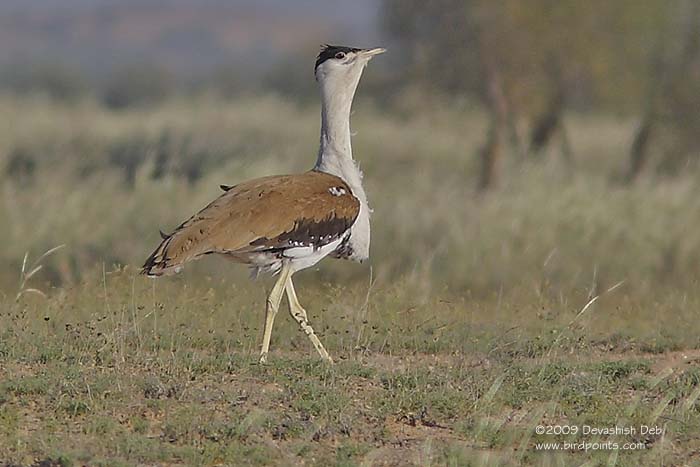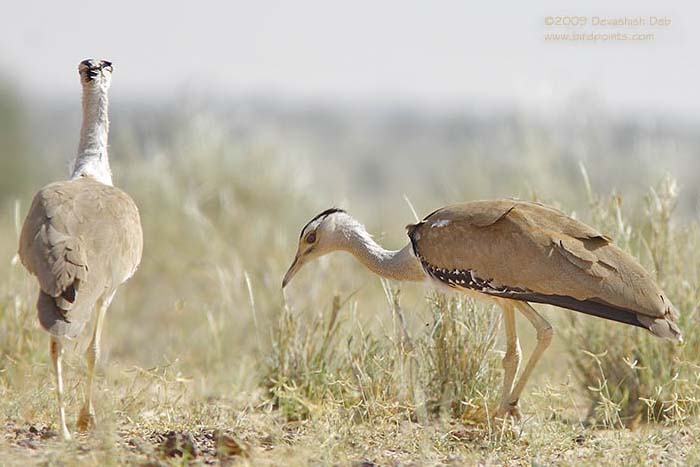|
|
| Indian
Bustard |
Ardeotis
nigriceps |
|
RG |
Great
Indian Bustard |
Ardeotis
nigriceps |
1
June 2009 |
| Full
Species (monotypic); i.e. no subspecies/races Ardeotis nigriceps; Vigors, 1831 |
Pls use the mousewheel
to zoom in/out (Max 2X) |

|

|
Sudashri,
Desert National Park, near Jaisalmer, Rajasthan, India, 3 March 2009.
Male |
Sudashri, Desert National Park, near Jaisalmer, Rajasthan, India, 3
March 2009. Females |
Historical
1414. Eupodotis edwardsi. The Great Indian Bustard. Otis edwardaii, Gray in Hardw. Ill Ind. Zool. i, pl. 59 (1830-32); Hume, S. F. i, p. 227; Adam, S. F. i, p. 393 : ii, p. 339. Otis nigriceps, Vigors, P.Z.S. 1831, p. 35; Sykes, P. Z. S. 1832, p. 155. Eupodotis edwardii, Blyth, Cat. p. 258. Eupodotis edwardsii, Jerdon. B. I. iii, p. 607; Stoticzka, J. A. S. B. xli, pt. 2, p. 250; Hayes Lloyd, Ibis, 1873, p. 415; Hume, N. & E. p. 557; Butler, S. F. iv, p. 9; ix, p. 424; Hume & Marsh. Game B. i, p. 7, pl.; iii, p. 423, pl. i (eggs); Davids. & Wend. S. F. vii, p. 87; Ball, ibid. p. 226; Hume, Cat. no. 836; Wilson, S. F. viii, p. 490; F. W. Butler, ibid.-, id. S. F. x, p. 161; W. Elliott, P. Z. S. 1880, p. 486; Tostems, S. F. x, p. 107 : Davidson, ibid. p. 318; Barnes, Birds Bom. p. 320; id. Jour. Bom. N. If. Soc. i, p. 57; vi, p. 11; Oates in Humes N. & E. 2nd ed. iii, p. 375; Sharpe, Cat. B. M. xxiii, p. 325; Rayment, Jour. Bom. N. H. Soc. ix, p. 107. Habits, &c. The Great Indian Bustard is usually found singly or in twos or threes, more rarely in flocks, and it keeps chiefly to open dry country, especially wastes covered with low grass and scattered cultivation, or sandy ground with small bushes; it is never found in forests nor on hills, but it sometimes enters high grass or fields of millet (jowari), mustard, pulse, &c. It feeds on insects, especially grasshoppers, on small reptiles, on fruit, grain, shoots of grass, &c. Its flight is heavy but strong. It has a peculiar deep booming note, imitated in its Mahratta name, and also a call-note, described by some observers as a bark or a bellow, by others as a trumpet sound. These birds, when in open ground, are very difficult to approach, except on a cart or camel or on horseback, or by the aid of a bullock or buffalo, but they squat and rest at times, and are then much less wary. The males are magnificent birds, often standing four feet in height, and they have a peculiar method, in the breeding-season especially, of inflating their white throats, doubtless by the aid of the gular pouch, and strutting about to attract the hens. Blanford,
W.T. 1895-98. The Fauna of British India, Including Ceylon and Burma.
Birds.- Vol. III-IV.
(Presented below is the evidence of the historical range enjoyed by this Endangered Bird. Citizenry of Delhi and nearby places will readily link to the towns mentioned - ED) "You say that the Great Indian Bustard does not occur in the North-Western Provinces, north and east of Jumna, but some few birds of this species are really always to be found in the Muzuffernugger district all through the year. "I yesterday put one up about six miles from my house, a cock. I saw a dead bird some years ago. Also, some years ago, while riding across from Roorkee to Bijnour, I saw a number of birds on some sandhills, which I then believed to be vultures. I had then never seen the Great Bustard. I was struck by the birds, and watched them for some time. Eventually I rode into them, and put them up; this was during the rains. I have no doubt now, especially after reading you remarks (p11) that these birds were Bustards. "Between the line of the railway and the Ganges canal, from near Roorkee to, I believe, Ghazeeabad, there runs a broken range of sandhills. Along this tract, right and left of the range, the land is high and sandy (bhoor), and here Bustards are to be found. I cannot positively assert that they extend into the Meerut district, but I believe such to be the case; and certainly a bird to be occasionally seen during the rains in the Saharunpore district, east of Deobund. "In this district (Muzuffernugger) they are to be found all the year round, and one was caught alive here some years ago for Mr. Craigie Halket by some bahelias. "The Bustard I saw yesterday, I flushed within a quarter of a mile of the Grand Trunk Road, (Merrut to Rookee) on some bhoorland close to a police outpost. "In 1871, I was in the Mirzapore district. I was told by residents, and also I think by Mr. Pollock, cs., that both Bustard and Florican were to be found some miles from the station, along the great Deccan road. "W. Ward Smith, an Assistant Engineer, D.P.W., stationed here tells me he frequently sees Bustard about Jowlee in the Muzuffernugger district." FW Butler Muzuffernugger, Oct 25th, 1879. |
About/Terms of use etc. at the home page
Copyright © 2006-2009 birdpoints. All rights reserved.